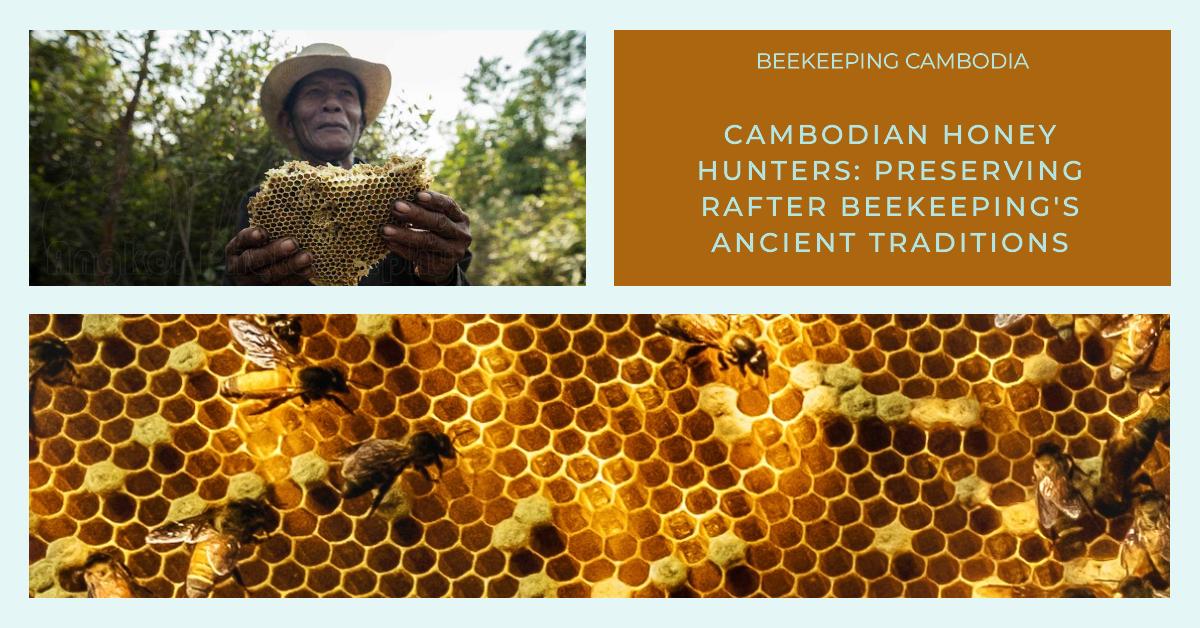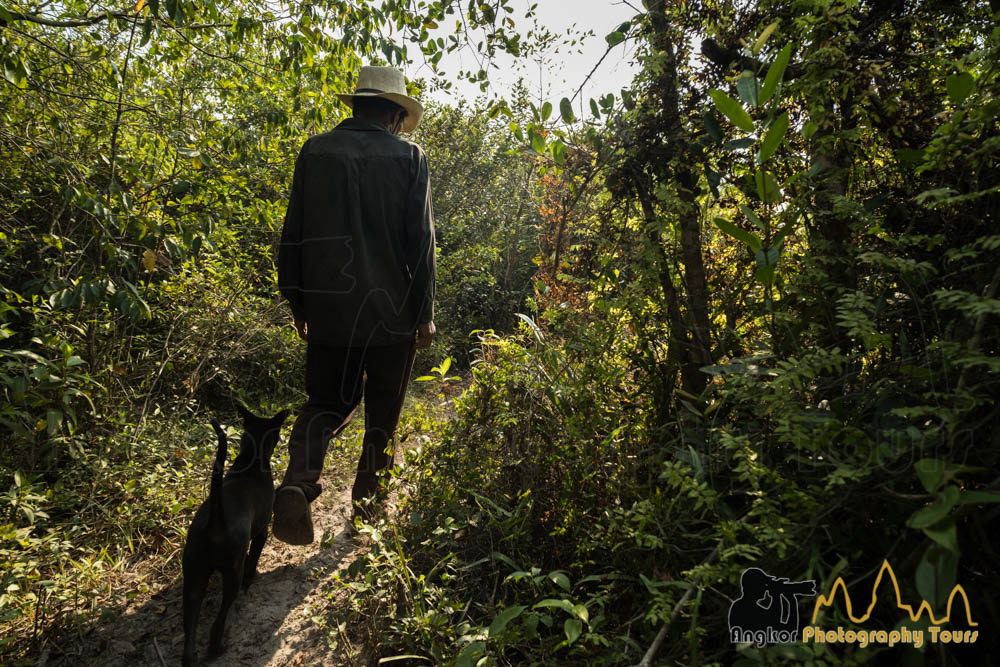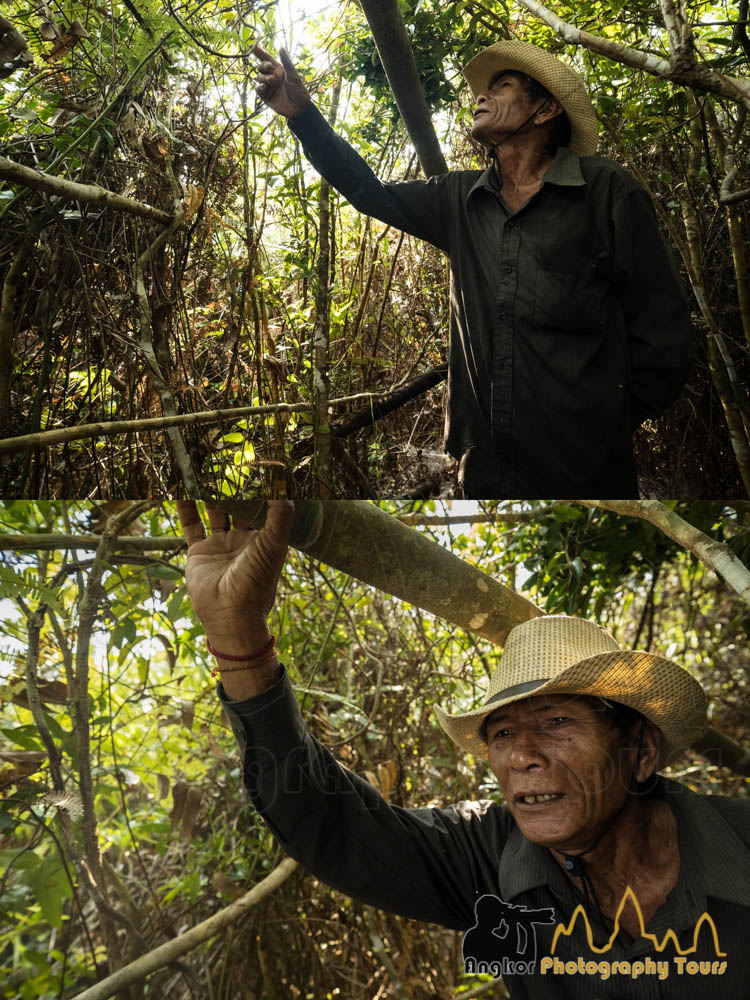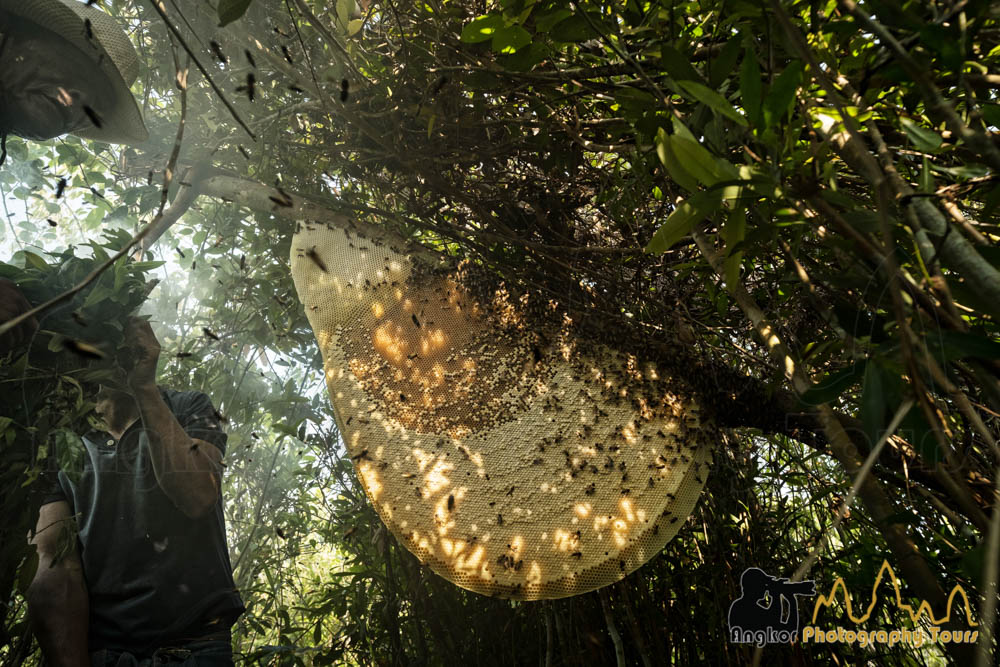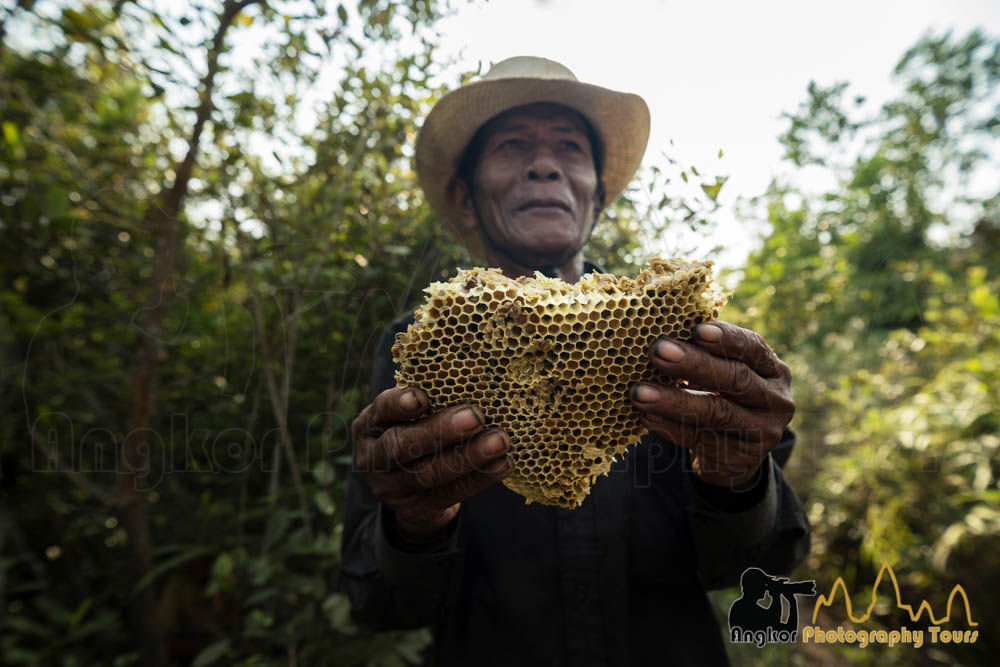ꙮ Beekeeping in Cambodia, a short overview
Beekeeping is an ancestral practice in Cambodia as evidenced in bas-relief depicting it on the terraces of the elephants, dating back to the 12th century. Nowadays, beekeeping in Cambodia is concentrated in specific areas like Siem Reap, Mondulkiri, and Koh Kong provinces, where honey bees are kept either in hives or on rafters. The honey harvested from these regions is substantial and serves as a valuable source of income for local communities. Starting around the year 2000, some NGOs and organizations (ACCB, USAID, Choice beekeeping) and individuals (Dani Jump, Eric Guerin) played a significant role in promoting sustainable beekeeping practices and educating others about the importance of bees.
ꙮ Rafter Beekeeping: A Unique Approach to Honey Harvesting
Rafter beekeeping is a traditional practice in northwestern Cambodia (Siem Reap, Mondulkiri), particularly during the dry season, carried out in degraded forest areas. This beekeeping method involves placing rafters, mimicking large tree branches, at a slight angle and low to the ground to encourage the settlement of giant honeybees. These bees typically establish their single-comb colonies high up in tall trees, making them difficult to access. Rafter beekeeping provides easy access to the comb and allows for multiple harvests, which can lead to increased honey production.
Sustainable rafter beekeeping involves a gentle and minimally disruptive approach to harvesting honey from the exposed honeycomb at the front of the nest, called the “honey head.” This allows the beekeeper to harvest some of the excess honey without disturbing or destroying the entire colony. The rest of the nest, including the brood comb where the eggs and larvae reside, is left intact. This allows the bee colony to remain viable and continue its lifecycle relatively undisturbed after the harvest.
ꙮ Beyond the Honeycomb: The Mighty Apis Dorsata, Nature’s Giant Honey Bee
Apis dorsata, known as the giant honey bee (Khmoom Thom in Khmer), is a species of honey bee native to South and Southeast Asia. This species is known for its large size (17–20 mm in length) and for its single, exposed combs on tree limbs or roof eaves.
Apis dorsata is closely related to Apis mellifera (the western honey bee), Apis cerana, and Apis florea. In Cambodia, beside Apis dorsata, Apis florea (the red dwarf honey bee) and Apis cerana, Apis mellifera (western honey bee) can also be found as well as some species of stingless bees.
Apis Dorsata are tropical and migrate seasonally, with individual colonies moving between nesting sites during the transition from the rainy to dry seasons. Some recent evidence indicates that Apis dorsata may return to the same nest site, though most, if not all, of the original workers might be replaced in the process. The large body size of Apis dorsata allows increased flight distance and foraging range compared to other honey bee species.
Apis dorsata is considered the most defensive of all honey bees and is known for its stingers that can be up to 3 mm long and easily penetrate clothing and fur. These bees are also capable of shimmering, a display of waves that moves across the surface of the nest in a fraction of a second, which is thought to intimidate potential threats.
If you look carefully, you can actually see Apis Dorsata in the temples of Angkor. Thousand of tourists are posing below one of the famous tree features early 2000s Tomb Raider film starring Angelina Jolie. not knowing that during some parts of the year, massive honeycombs are hanging as high as 20 meters up in the tree.
Apis dorsata nests can also be found much lower to the ground hanging under some rooftops at Preah Khan temple.
ꙮ A beekeeping tour with Chhoin, master Khmer honey hunter
On a hot and humid February afternoon, we embarked on a beekeeping tour, taking the road from Siem Reap to area north west not far the Kulen mountains. The trip was organized by Eric Guerin, an expert in sustainable beekeeping in Cambodia and South East Asia. After an hour on a last stretch of bumpy road, we arrived at Chhoin’s family house, the starting point of our beekeeping tour.
We started started walking on a trail, just across the street from the house following Chhoin, his son and grandson. It was a first for us so we did not know what to expect, Eric had just warned us to wear long sleeves and that the ground would be muddy.
After hiking for around 20 minutes through the regenerating lower secondary forest, we reached our first destination, an empty rafter. At this point, Chhoin explained to us, with the assistance of our translator Ranith, the design and construction of the rafter.
The next stop was a live honeycomb. I followed Chhoin closely though some dense vegetation while wearing a beekeeper’s hat when he stopped suddenly and in a the distance in the distance, about 5 or 6 meters away, I then saw a huge honeycomb hanging from a rafter. Despite the fact that we stayed low to the ground, the honeybees started making waves that rippled across their nest, indicating that they felt threatened and were ready to attack. I just had the time to shot one picture. For safety, Jar asked me to go back to the main trail.
Prior to our third and final stop at the beehive rafters, Chhoin and his son meticulously prepared a smoking device over the course of approximately 25 minutes. They gathered various tree leaves, branches, and herbs, tying them together and then igniting the bundle with a lighter. Once the smoking device was ready, we walked over to the nearby rafter.
We approached the nest while making sure to stay close to the white fumes. Not far from the rafter we were struggling to walk and few times I was knee deep into the mud. It was worth it as the honeycomb was huge and already plenty of bees left the nest in chaos because of the smoke.
.
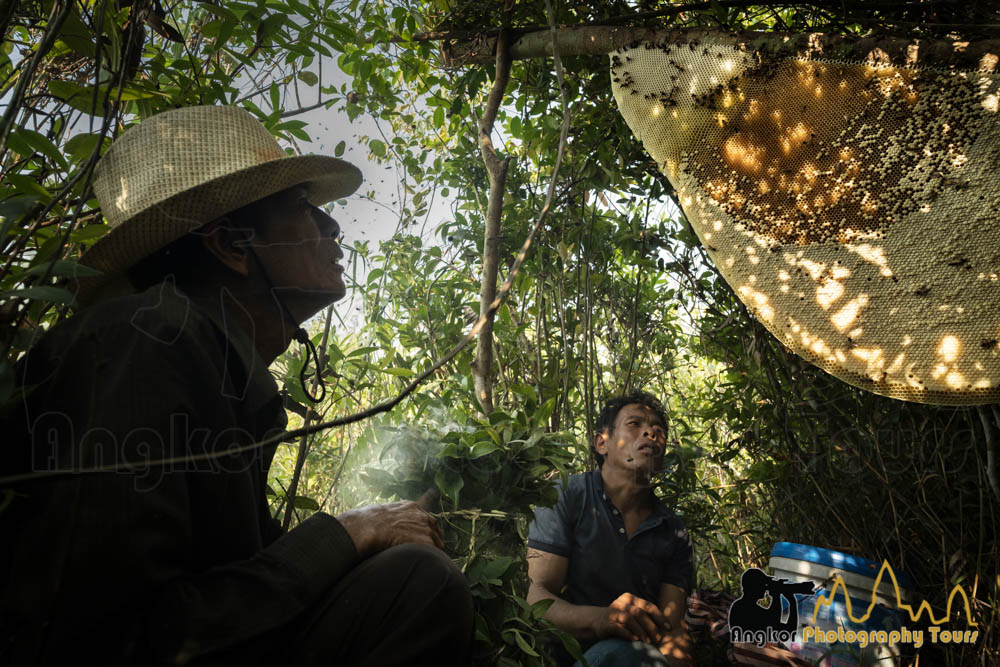
I had my 13mm ultra wide lens plugged on my Fuji so the only option was to get very close to the nest to capture pictures and the nest and the bee’s collecting process. We were all wearing beekeeping hats but Chhoin and his son did not have any protection at all and relying only on their smoking device.
I had my sleeves on and was wearing long trousers but a bee still manage to sting me on my tight. The pain from that sting went away quite fast, so probably the stinger didn’t stay in. I got another sting more painful in on my finger.
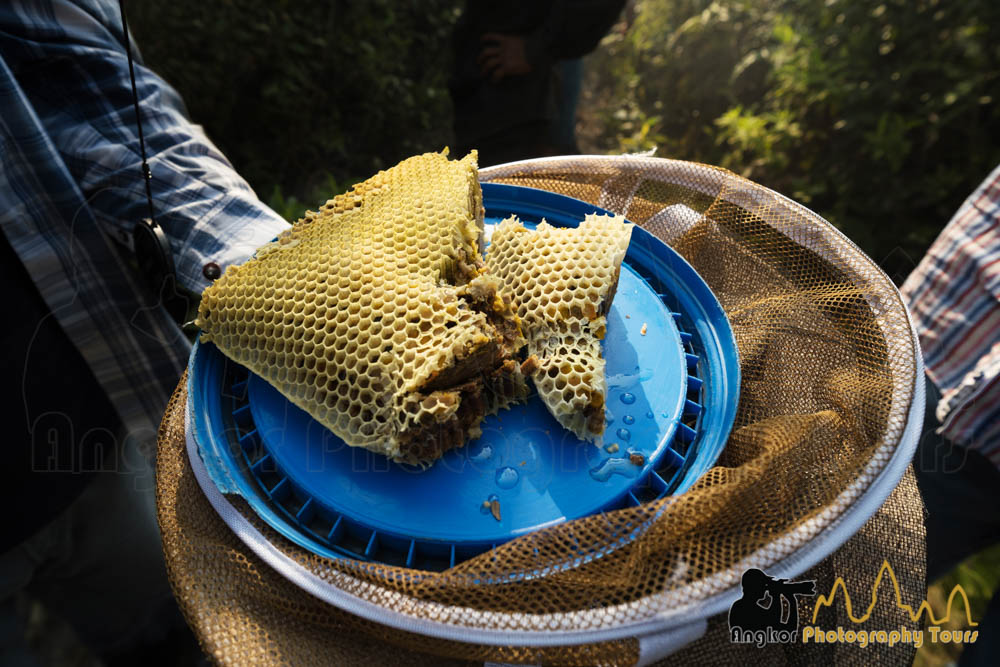
Freshly cut wild honeycomb
ꙮ Challenges Facing Rafter Beekeeping in Cambodia
Rafter beekeeping faces multiple threats, including changing agricultural and construction activities that remove hive sites and nesting habitats, deforestation, pesticide use reducing available forage, lower startup costs of modern box hives leading beekeepers to transition away from traditional methods, climate change and extreme weather events, and lack of training opportunities for younger generations to perpetuate these traditions. Chhoin mentioned that he was managing only 10 rafters compared to 100 only few years ago.
ꙮ Beekeeping in Cambodia | Initiatives
ꙮ Beekeeping trainings
Some efforts are underway to sustain this practice, with government, NGOs, and associations initiating training programs for rafter beekeeping and promoting its sustainability. In 2019, Eric Guerin, commissioned by the WMF, wrote a training manual about rafter beekeeping sustainable practices.
ꙮ Women for Bees | Angelina Jolie
Eric Guerin is involved as well with the Angelina Jolie’s beekeeping project through partnerships with UNESCO and Guerlain. During her last visit in 2022, she launched “Women for Bees“, a training program to support beekeeping initiatives, aiming to empower Cambodian women and repopulate dwindling bee populations, crucial for pollination and food security.
ꙮ Where to buy honey in Cambodia?
You can buy directly the wild honey at Chhoin’s home. The price is USD 10 for 500mL. If you buy honey from a shop in Siem Reap, it is good to know where the wild honey is coming from and what treatments were applied before being bottled. Honey is usually let settle for 4-5 days and filtered with a strainer to remove impurities before being transferred in a bottle or container. Be sure that the container was stored properly in cool, dry place away from sunlight.
The Cambodia Federation for Bee Conservation and Community-based Wild Honey Enterprise (CBHE) are awarding certifications to a network community-based honey enterprises that meet specific standards.
.
ꙮ References
Cambodia MSME 2/BEE project. Wild honeybee baseline survey. https://pdf.usaid.gov/pdf_docs/PA00HV21.pdf accessed 12 March 2024
Eric Guerin. Rafter beekeeping. Sustainable management with Apis Dorsata – Training manual. WWF Report, 2019. https://d2ouvy59p0dg6k.cloudfront.net/downloads/100120_training_manual_for_rafter_beekeeping_final.pdf accessed 12 March 2024
Bee Unlimited website. https://www.beesunlimited.com. Accessed 12 March 2024
- Meak Bochea: Celebrating Buddha’s Final Teaching in Siem Reap Cambodia - February 14, 2025
- Angkor Wat Marathon - June 22, 2024
- Timelapse calculator - June 22, 2024
